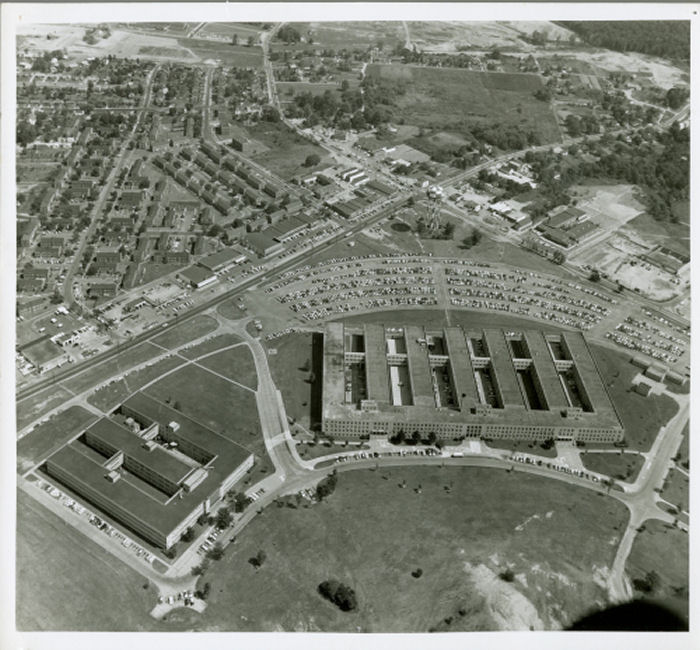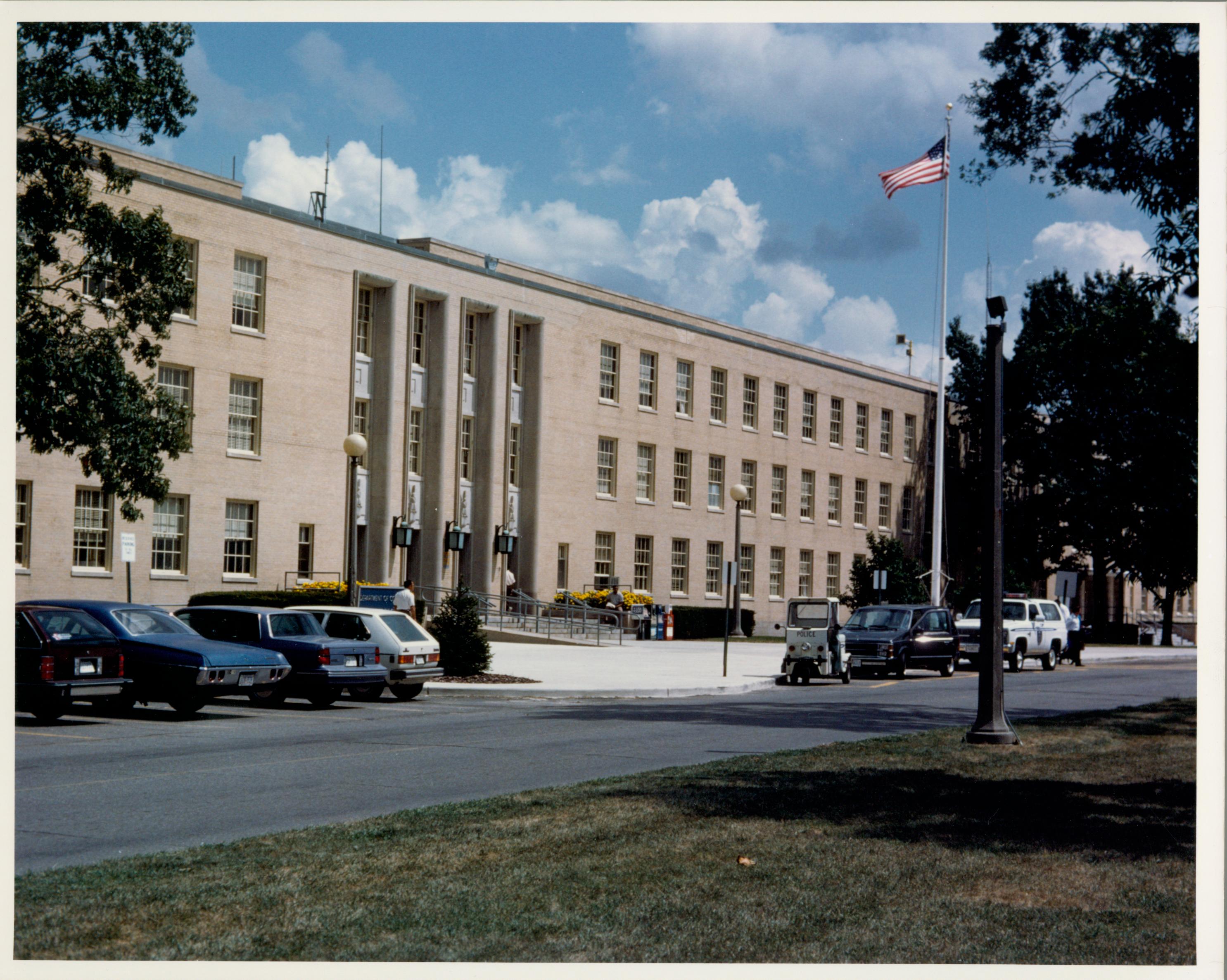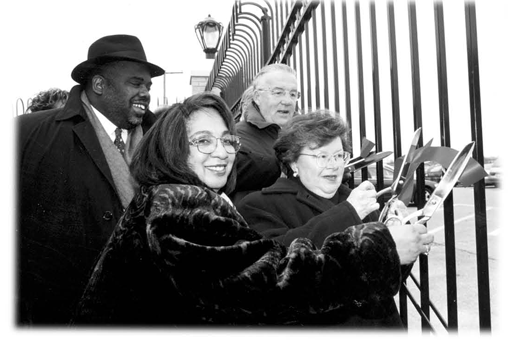end of header
History
You are here: Census.gov › History › Agency History › Suitland, MD › Suitland Federal Center
Suitland, MD
Suitland Federal Center

View larger image
Federal Office Building No. 3.
With the onset of U.S. involvement in World War II, the federal government needed space to house the bureaucracy required to support the war effort. In 1941, the government purchased 437 acres of farm and dairy land in Suitland, Maryland, just outside Washington, DC. There were 12 residences on the property, with modest commercial development near the intersection of Suitland and Silver Hill Roads. There was also a small airfield, Skyhaven Airport.
While still in the planning stage, the Suitland Federal Center was characterized by the Washington Post as a "suburban government-office city" that might eventually rival in size Washington's Federal Triangle.
But this Public Buildings Administration's (The Public Building Administration was the precursor to today's General Services Administration (GSA)) "dream project" was not without some controversy. The Maryland National Capital Park and Planning Commission opposed it because available water and sewerage facilities could not accommodate such a large development. Senators Robert R. Reynolds (D-NC) and John Holmes Overton (D-LA) made a belated plea to keep government buildings inside the District of Columbia where they belonged. The senators' plea may have been more in response to a proposal by an Illinois lawmaker to move some agencies to Chicago, rather than concern over a move to Suitland.
In September 1941, the Public Buildings Administration (PBA) awarded a $2,749,000 contract to McCloskey & Co. of Philadelphia for a new Federal Office Building in Prince Georges County, Maryland.
The Census Bureau was the first agency to occupy the site, moving its headquarters into the Federal Office Building No. 3.
The Washington Star had this to say on December 1, 1941: "This air view of Federal Office Building No. 3 at Suitland, Md., looking southeast, shows progress of construction on the $4,100,000 project. The Silver Hill Road crosses the picture beyond the 430-acre building site and the Suitland School can be seen in the center background facing the road. The Suitland Road intersects from the left. The building will house about 4,500 workers and is about 6 miles from the Capitol. The Washington Suburban Sanitary Commission is selling a bond issue to provide funds for water and sewer facilities and special zoning powers have been granted Prince Georges County commissioners to protect the area. It has not been decided what offices will occupy the building."
In 1943, the Suitland site was split in two by the construction of the Fighter Command Station Access Parkway, later renamed the Suitland Parkway, to connect Bolling Air Force Base with the Camp Springs Military Reservation (later renamed Andrews Air Force Base). The southern portion of the site was incrementally transferred to the Smithsonian Institution starting in 1951; .8 acres were transferred to the Silver Hill Volunteer Fire Department in 1963, and 4.4 acres were transferred to the State Roads Commission of Maryland, for the widening of Silver Hill Road, in 1964.

View larger image
Federal Office Building No. 3 in the 1980s.
Other tenants of the Suitland Federal Center have included the Naval Oceanic Office, the U.S. Weather Bureau, the Federal Records Center, the Naval Intelligence Support Center, the Smithsonian Institution, the Naval Ice Center, the Federal Protective Service, the 1996 Inaugural Committee, the National Archives and Records Administration, the Naval Maritime Intelligence Center, the Government Services Administration, and the Army Communications Command.
The Naval Hydrographic Building, also known as the Naval Intelligence Command Building or NIC-1, was completed in 1942 at a cost of $1,481,221. Originally it housed staff involved in underwater charting and naval aerial photography. Redesignated as the U.S. Naval Oceanographic Office (NAVOCEANO) in 1962, its operations were relocated to the National Aeronautic and Space Administration's Stennis Space Center in Mississippi, in 1976. Naval intelligence operations continued in the building until it was demolished in the early 1990s. The building was located between FOB-3 and the Metro parking lot.
In 1942 barracks were constructed near Silver Hill Road and Suitland Parkway, on the site of the current Metro parking garage. The barracks were demolished in 1975.
Federal Office Building 4 was designed as the fourth in the series of federal office buildings, and was completed in 1947 at a cost of $2,327,280. It originally consisted of three interconnected wings; a fourth wing was added in 1960.
The Department of the Navy built Suitland Federal Center 2, to house the Naval Photographic Interpretation Center, in 1958. The building was renamed the Naval Reconnaissance and Technical Support Center, and then the Naval Intelligence Command Building 2 (NIC 2). A second floor was added to the northern portion in 1970 and two prefabricated temporary structures were erected in the original courtyards. The Naval Intelligence Command occupied the building until 1994. The building was renamed Suitland Federal Center 2 and was assigned to the 1996 Armed Forces Inaugural Committee, which never moved in. Staff from the Federal Protective Service and the General Services Administration currently occupy the building.
In the days following U.S. entry into World War II, reports circulated that underground vaults were being prepared in Suitland to house such valuable national documents as the Constitution and the Declaration of Independence in the event of an enemy air raid on the capital. However, the Government Services Administration (GSA) reports that three underground storage facilities were built in 1946. Vaults A, B and C were located just inside the Federal Center on Suitland Road, across from Shadyside Avenue. The Library of Congress was one of the last tenants here and used the vaults for microfilm. The last of the vaults was destroyed by fire in the mid 1990s and demolished. The vaults, however, live on in the popular imagination, fueled by conspiracy theorists and an episode of the television series, The X-Files.
In 1943, after canned vegetables were stringently rationed, Census Bureau officials opted to turn some 14 acres of land at the Federal Center into the largest Victory Garden in the Washington area. Employees could help the war effort by growing vegetables for themselves and their families. The 14 acres were plowed, fertilized and limed and divided into 616 plots. Scrap lumber from packing crates from the Navy Hydrographic Office was sawed into some 2,464 stakes to mark the plots. Plots, rented for $1.50 each, were 15 feet wide and 50 feet long. Narrow paths between the plots allowed for relatively easy access. Prizes of war bonds and war stamps were awarded to the employees with the most original, best standard, and best ladies' garden. It was reported that the 1943 harvest was fairly successful, despite the drought.
As late as 1989, there were still 110 garden plots on the reservation, double the size of the 1943 plots. They could be rented for the entire summer from the Census Bureau Welfare and Recreation Association on a first-come, first-served basis for seven dollars each. The victory gardens were located where the Naval Intelligence Building now stands.
The Suitland Garage and Annex, located near the back of FOB-3's Wing 7, was built in 1949 and demolished in 2004.
The Washington Records Center was constructed for the National Archives and Records Administration (NARA) in 1967. It currently houses both NARA and the Federal Protective Service's mega center.
Lovell O. Minear, owner and developer of Lincoln Memorial Cemetery, located on Suitland Road, built the Suitland House in 1938. After the federal government acquired Suitland Federal Center, the house was used as a daycare for children of Census Bureau employees. Since then, it has been converted to office space. Most recently, it was the administrative office overseeing the construction of the Census Bureau's new headquarters building. Prince George's County designated Suitland House a historic site in 1999, and it will remain part of the federal campus.
In 1991 the Naval Maritime Intelligence Center was constructed for the Navy on 41 acres of land that included 3 ball fields used by Census Bureau recreational teams.
In 1994, the Washington Metropolitan Area Transit Authority acquired property at the southeastern corner of the Suitland Federal Center. In January 2001, Metro's green line was extended to the new Branch Avenue station. Census Bureau employees had their own long-awaited Metro stop at the Suitland station.
Close to where the the victory gardens once grew, several playing fields had been constructed for use by various Census Bureau teams. When ground was broken for the Naval Intelligence Building, two new fields were created between Building 2 and the Washington Records Center. When ground was broken for the new NOAA building, Census Bureau teams moved to a local elementary school.
The Suitland Child Development Center, which is used by employees of the Census Bureau, NOAA and the Navy, opened in 2003.
The NOAA Satellite Operations Facility Building, next to SFC 2, was completed in 2005.

View larger image.
Fence dedication: Front to back: President
of AFGE Local 2782, Avis Buchanan, Sen. Mikulski,
Sen. Sarbanes and Rep. Wynn cut the ribbon.
Photo courtesy of the Public Information Office,
U.S. Census Bureau.
Through the mid-1980's, the grounds of the Suitland Federal Center were open to the public and the entrances to FOB 3 were left unguarded. However, in the late 1980s, car thefts in the parking lot and petty theft in various offices brought about the need for enhanced security. Additional security personnel and procedures have been added over the years since then. A chain-link fence, topped with barbed wire, was erected around the perimeter of the complex, but was replaced in January 2000 by the current, more neighborhood-friendly, black wrought-iron fence.
The groundbreaking ceremony for a new Census Bureau headquarters building took place on September 16, 2003. It officially opened in 2007.
Comments or suggestions?




